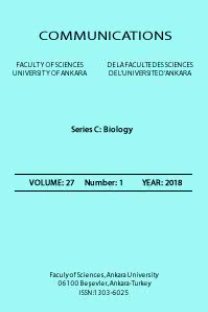DIFFERENTIATION OF THERMAL PROPERTIES OF POLLENS ON GENUS LEVEL
Thermal stability, pollen, genus level, Salix, Betula, Fraxinus
___
[1] E. Katifori, S. Alben, E. Cerda, D.R. Nelson, J. Dumais, Foldable structures and the natural design of pollen grains. Proceedings of the National Academy of Sciences, 107/17, (2010) 7635–7639.[2] T. Ceter, N.M. Pınar, H. Inceer, S. Hayırlıoglu Ayaz, A.E. Yaprak, The Comparative pollen morphology of genera Matricaria L. and Tripleurospemum Sch. Bip. (Asteraceae) in Turkey. Plant Systematics and Evolution, 299(5), (2013) 959-977
[3] T. Ceter, M. Ekici, N.M. Pınar, F. Ozbek, Pollen morphology of Astragalus L. section Hololeuce Bunge (Fabaceae) in Turkey. Acta Botanica Gallica, 160(1), (2013) 43-52.
[4] R.G. Stanley, H.F. Linskens, Pollen: biology biochemistry management. Springer Science & Business Media, (2012).
[5] T.D. Quilichini, E. Grienenberger, C.J. Douglas, The biosynthesis, composition and assembly of the outer pollen wall: A tough case to crack. Phytochemistry, 1/113, (2015) 170-182.
[6] M. Mujtaba, I. Sargin, L. Akyuz, T. Ceter, M. Kaya, Newly isolated sporopollenin microcages from Platanus orientalis pollens as a vehicle for controlled drug delivery. Materials Science and Engineering: C, 77, (2017) 263-270.
[7] M. Kaya, L. Akyuz, I. Sargin, M. Mujtaba, A. M. Salaberria, J. Labidi, Y.S. Cakmak, B. Koc, T. Baran, T. Ceter, Incorporation of sporopollenin enhances acid–base durability, hydrophobicity, and mechanical, antifungal and antioxidant properties of chitosan films. Journal of industrial and engineering chemistry, 47, (2017) 236-245.
[8] Y. Wang, L. Shang, G. Chen, C. Shao, Y. Liu, P. Lu, F. Rong, Y. Zhao, Polleninspired microparticles with strong adhesion for drug delivery. Applied Materials Today, 13, (2018) 303-309.
[9] R. B. Prime, H. E. Bair, S. Vyazovkin, P. K. Gallagher, A. Riga Thermogravimetric analysis (TGA), Thermal analysis of polymers: Fundamentals and applications, 1, (2009) 241-317.
[10] H. H. Horowitz, G. Metzger, A new analysis of thermogravimetric traces, Analytical Chemistry, 35(10), (1963) 1464-1468.
[11] J. Golebiewski, A. Galeski, Thermal stability of nanoclay polypropylene composites by simultaneous DSC and TGA. Composites Science and Technology, 67/15-16, (2007) 3442-3447.
[12] S. Y. Lee, D. J. Mohan, I. A. Kang, G. H. Doh, S. Lee, S. O. Han, Nanocellulose reinforced PVA composite films: effects of acid treatment and filler loading. Fibers and Polymers, 10(1), (2009) 77-82.
[13] S. Renneckar, A. G. Zink‐Sharp, T. C. Ward, W. G. Glasser, Compositional analysis of thermoplastic wood composites by TGA. Journal of applied polymer science, 93(3), (2004) 1484-1492.
[14] R. C. Mackenzie, Nomenclature in thermal analysis, part IV. Thermochimica acta, 28(1), (1979) 1-6.
[15] I. Sargın, G. Arslan, Chitosan/sporopollenin microcapsules: Preparation, characterisation and application in heavy metal removal. International journal of biological macromolecules, 75, (2015) 230-238.
[16] Y. Motomura, T. Watanabe, A. S. Kiyoshi, Studies on honey and pollen vi. On the sugar composition of several kinds of pollen, Tohoku journal of agricultural research, 13(3), (1962) 237-244.
[17] R. Pini, G. Furlanetto, L. Castellano, F. Saliu, A. Rizzi, A. Tramelli, Effects of stepped-combustion on fresh pollen grains: Morphoscopic, thermogravimetric, and chemical proxies for the interpretation of archeological charred assemblages. Review of Palaeobotany and Palynology, 259, (2018) 142-158.
- ISSN: 1303-6025
- Yayın Aralığı: Yılda 2 Sayı
- Başlangıç: 1943
- Yayıncı: Ankara Üniversitesi
ANTIMICROBIAL ACTIVITIES OF SOME BRYOPHYTES IN TURKEY
Şenol ALAN, Ferudun KOÇER, Güray UYAR
EFFECTS OF GLOBAL-WARMING AND CLIMATE-CHANGES ON ATMOSPHERIC FUNGI SPORES DISTRIBUTION
POLLEN MORPHOLOGY STUDIES ON TWO EUPHORBIA L. (EUPHORBIACEAE) TAXA FROM TURKEY
Ümmüşen GÖKÇEN, İsmühan POTOĞLU ERKARA, Okan SEZER, Onur KOYUNCU, Ömer Koray YAYLACI
FLORA AND HABITAT DIVERSITY OF KAVUNCU SALTMARSH
G. Nilhan TUG, A. Emre YAPRAK, S. Tuğrul KORUKLU, Ümit BINGOL
ALLERGENIC COMPOUNDS IN HONEY BEE PRODUCTS
COMPARISON OF TWO AEROBIOLOGICAL STATIONS DATA IN ZONGULDAK
ANTIOXIDANT AND PHYSICOCHEMICAL PROPERTIES OF CHESTNUT HONEYS FROM TURKEY
BEE POLLEN AND ITS PHARMACOLOGICAL PROPERTIES
INVESTIGATION ON POLLEN MORPHOLOGY OF TWO GAGEA SALISB. TAXA FROM TURKEY
Okan SEZER, Ali Can YILDIZ, Onur KOYUNCU, Koray YAYLACI, İsmühan POTOĞLU ERKARA
